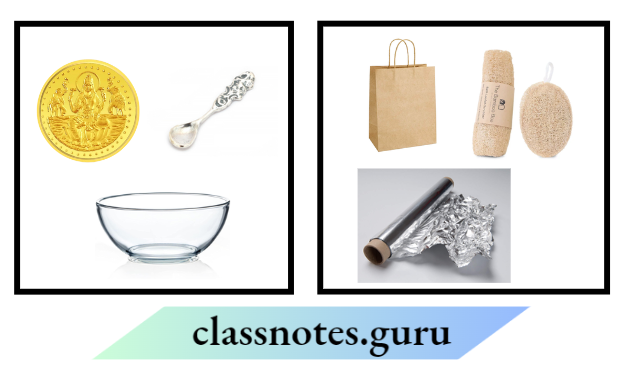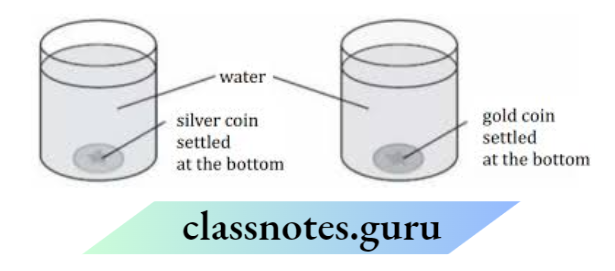Sorting Materials Into Groups Multiple Choice Questions
Question 1. Which object is commonly made up of plastic?
- House gate
- Sleeping cot
- Cooking vessel
- Water bottle
Answer: 4. Water bottle
Question 2. Neeraj spilt some water on the floor. He cleaned the floor using a mop. Which material is best suited for making the mop?
- Iron scrubber
- Cotton cloth
- Plastic sheet
- Copper sheet
Answer: 2. Cotton cloth
Question 3. Which among the following are commonly used for making a safety pin?
- Wood and glass
- Plastic and glass
- Leather and plastic
- Steel and plastic
Answer: 4. Steel and plastic
Read and Learn More NCERT Class 6 Science MCQs

Question 4. Find the odd one out from the following.
- Tawa
- Spade
- Pressure cooker
- Eraser
Answer: 4. Eraser
Question 5. Rakesh collected spoons made up of plastic, metal, glass and wood. Which of the following observations regarding each will be correct?
- Glass spoon will not break if dropped on the floor
- A wooden spoon will let liquid pass through it
- Plastic spoons will deform in hot temperature
- A metallic spoon can easily bend with pressure
Answer: 5. Metallic spoon can easily bend with pressure
Question 6. The picture shows two hollow pipes. One pipe is made up of copper and the other is made up of plastic.

Which of the following will help to identify the pipe made up of copper?
- Place the pipes in water and check if they absorb water
- Rub the pipes with sandpaper and check if they appear shiny
- Hold the pipes under a glowing bulb and check if they produce shadows
- Bring the pipes near a magnet and check if they are attracted by the magnet
Answer: 4. Bring the pipes near a magnet and check if they are attracted by the magnet
Question 7. An iron nail is kept in each of the following liquids. In which case would it lose its shine and appear dull?
- Mustard oil
- Soft drink
- Coconut oil
- Kerosene
Answer: 4. Kerosene
Question 8. Which of the following materials is not lustrous?
- Gold
- Silver
- Wood
- Diamond
Answer: 3. Wood
Question 9. The table shows objects sorted into two groups.

Which property was used to sort the objects into two groups?
- Hard/soft
- Shiny/dull
- Transparent/opaque
- Water soluble/water insoluble
Answer: 1. Hard/soft
Question 10. Arrange the following objects in order from hardest to softest.
- Rubber ball
- Cricket ball
- Stone
- Cotton ball
The correct order would be
- 1,2, 3, 4
- 4, 1,2,3
- 2,1,3,4
- 3, 2, 1,4
Answer: 4. 3, 2, 1,4
Question 11. Which of the following materials is rough?
- Sheet of glass
- Steel
- Stone
- Rubber
Answer: 3. Stone
Question 12. Pick one material from the following which is completely soluble in water.
- Chalk powder
- Tea leaves
- Glucose
- Sawdust
Answer: 3. Glucose
Question 13. Liquids that mix completely are called
- Volatile
- Immiscible
- Miscible
- Solution
Answer: 3. Miscible
Question 14. Oil floats on water. This is because
- It is denser than water
- It is less dense than water
- It is soluble in water
- Both have equal density
Answer: 2. It is less dense than water
Question 15. Rajiv dropped a silver and a gold coin each in a jar of water.

Which question can be answered from the activity?
- Do gold and silver coins float on water?
- Is the gold coin harder than the silver coin?
- Is the gold coin heavier than the silver coin?
- Do gold and silver coins change size in water?
Answer: 1. Do gold and silver coins float on water?
Question 16. A coin, a sheet of paper and a gold ring were dropped in a glass of water. Which of these will sink and which will float?
- Coin and gold ring will float, while a sheet of paper will sink
- The coin will float, while the gold ring and sheet of paper will sink
- Sheet of paper will float, while gold rings and coins will sink
- The coin, gold ring and sheet of paper would all sink down
Answer: 3. The Sheet of paper will float, while the gold ring and coin will sink
Question 17. Which pair of substances among the following would float in a tumbler half-filled with water?
- Cotton thread, thermocol
- Feather, plastic ball
- Pin, oil drops
- Rubber band, coin
Answer: 2. Feather, plastic ball
Question 18. You are provided with the following materials
- Magnifying glass
- Mirror
- Stainless steel plate
- Glass tumbler
Answer: 3. Stainless steel plate
Question 19. Which of the above materials will you identify as transparent?
- 1 and 2
- 1 and 3
- 1 and 4
- 3 and 4
Answer: 1. 1 and 2
Question 20. Which type of the following materials is used for making the front glass (windscreen) of a car?
- Transparent
- Translucent
- Opaque
- All of these
Answer: 3. Translucent
Question 20. While doing an activity in class, the teacher asked Paheli to hand a translucent material. Which among the following materials will Paheli pick and give to her teacher?
- Glass tumbler
- Mirror
- Muslin cloth
- Aluminium foil
Answer: 3. Glass tumbler
Question 21. Which of these is a translucent object?
- An iron plate
- A glass sheet
- A concrete slab
- A sheet of tissue paper
Answer: 4. A sheet of tissue paper
Question 22. Boojho found a bag containing the following materials
- Mirror
- Paper stained with oil
- Magnet
- Glass spectacles
Help boojho in finding out the material(s) which is/are opaque.
- Only 1
- Only 4
- 1 and 3
- 2 and 4
Answer: 3. 1 and 3
Question 23. You are provided with a cardboard, a piece of glass, ice and a sheet of steel. Which of the following is the correct observation about the above materials?
- Only ice is opaque
- Only piece of glass is transparent
- Cardboard is translucent
- Ice and pieces of glass are transparent
Answer: 4. Ice and pieces of glass are transparent
Question 24. Glass can be made opaque by
- Spreading oil on it
- Spreading water on it
- Painting one side of it
- Pasting a thin sheet of paper on one side of it
Answer: 3. Painting one side of it
Question 25. Which of the following statements is not true?
- Materials are grouped for convenience
- Materials are grouped to study their properties
- Materials are grouped to remember their names
- Materials are grouped according to their uses
Answer: 3. Materials are grouped to remember their names
Question 26. Which of the following objects is not made up of metal?
- Wallet
- Knife
- Neavy machine
- Utensils
Answer: 1. Wallet
Question 27. Which one of the following objects will not tarnish in water?
- Iron piece
- Gold ring
- Silver ring
- Copper wire
Answer: 2. Gold ring
Question 28. A pair of objects having the same physical properties is
- Iron, bread
- Honey, sand
- Gold, silver
- Wood, cotton ball
Answer: 3. Gold, silver
Question 29. Pick one material from the following which is completely soluble in water.
- Chalk powder
- Tea leaves
- Glucose
- Sawdust
Answer: 3. Glucose
